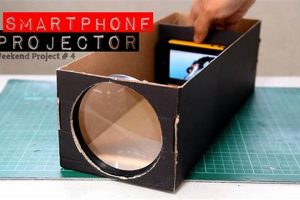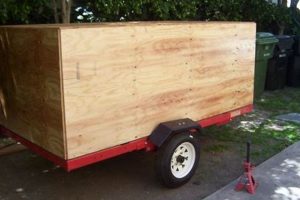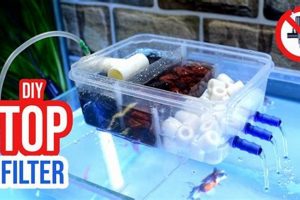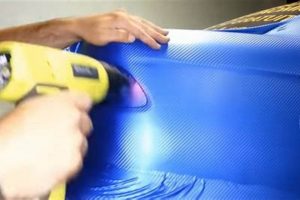The practice of creating purified HO at home involves a process of boiling water and collecting the resulting steam, which is then condensed back into a liquid. This method separates water molecules from impurities that have a higher boiling point, such as minerals and salts. A common example involves using a large pot, a heat source, and a collection vessel to capture the purified condensate.
This procedure offers a cost-effective alternative to purchasing commercially produced versions, potentially reducing reliance on plastic containers and associated environmental impact. Historically, individuals and communities in remote locations, or those facing limited access to refined resources, have employed similar techniques for obtaining potable water. The ability to create a cleaner water source has implications for drinking, cleaning, and specific applications requiring high purity.
The following sections will elaborate on the practical aspects of home purification, including various methods, safety considerations, and comparisons with other water treatment options. Additionally, the applications and limitations will be examined to provide a well-rounded understanding of this resource.
Tips for Home Water Purification
This section provides practical guidance to maximize the effectiveness and safety when performing home water purification. Adhering to these guidelines promotes successful results and minimizes potential hazards.
Tip 1: Source Water Quality Assessment: Evaluate the source water before commencing. Severely contaminated water may require pre-treatment, such as filtering, to remove gross particulate matter. Start with the cleanest available water to enhance the quality of the final product.
Tip 2: Equipment Sanitation: Thoroughly clean all equipment before each use. Residues or contaminants present in pots, tubing, or collection containers will negatively impact the purity. Sterilization is advisable, particularly for applications requiring high purity.
Tip 3: Temperature Control: Maintain a consistent boil during the evaporation stage. Fluctuations in temperature can affect the efficiency of the purification process. A controlled heat source allows for better regulation.
Tip 4: Condensation Surface Material: Choose condensation surfaces wisely. Avoid using reactive metals or plastics that might leach chemicals into the purified water. Stainless steel or glass are preferable materials.
Tip 5: Collection Vessel Hygiene: Employ a sterile collection vessel. The final product can be easily contaminated if stored improperly. Use a sealed container to maintain water purity.
Tip 6: Monitoring pH Levels: Test the pH of the final product. Ideally, it should be close to neutral (pH 7). Deviations from this can indicate contamination or residual impurities. Utilize pH testing strips or a digital meter for accurate readings.
Tip 7: Proper Ventilation: Ensure adequate ventilation in the area where the procedure is performed. The boiling process releases steam, which can contribute to humidity and potential mold growth. Good airflow prevents moisture buildup.
Implementing these tips results in a safer and more effective process, ultimately yielding a cleaner and more reliable water source. Consistent application of these principles ensures a higher quality product for various applications.
The following section will provide detailed methods for different processes of at-home water purification. It will also dive deeper into the many applications of this resource.
1. Equipment sterilization
The process of home water purification relies heavily on minimizing contamination to produce water of suitable quality. Equipment sterilization plays a critical role in this regard. The presence of microorganisms, mineral deposits, or chemical residues within the equipment used, such as pots, tubing, and collection containers, will inevitably transfer to the resulting water. This diminishes the effectiveness of the purification process and can introduce undesirable or harmful substances.
Consider the example of a pot previously used for cooking salty foods. Even after washing, microscopic salt particles may remain adhered to the surface. During purification, these particles will vaporize and re-condense, thereby contaminating the final product. Similarly, bacterial biofilms present in inadequately cleaned tubing can proliferate and introduce biological contaminants. Therefore, employing sterilization techniques like boiling equipment for a specified duration, or using chemical sterilants, is imperative.
In summary, the effectiveness of home water purification is directly dependent on the degree of equipment sterilization. Thorough sterilization procedures minimize the introduction of contaminants, resulting in a purified water source suitable for various applications. Without consistent and effective sterilization, the water obtained may not meet the purity standards required for its intended use, negating the benefits of the purification process.
2. Source Water Purity
The initial quality of the water used significantly impacts the outcome when creating purified water at home. Source water contaminants can carry over into the final product, diminishing the benefits of the purification process. Therefore, understanding and addressing the source water’s composition is crucial.
- Mineral Content
Source water contains dissolved minerals, such as calcium, magnesium, and sodium. While the purification process aims to remove these, excessively high mineral concentrations in the source water can reduce the process efficiency. For instance, hard water will require additional energy input to effectively evaporate and separate the water from the mineral residue. The final product might also retain trace amounts of these minerals, depending on the method employed.
- Organic Contaminants
Organic compounds, including pesticides, herbicides, and volatile organic chemicals (VOCs), present in the source water can pose a challenge. Some VOCs have lower boiling points than water, and therefore can evaporate and condense along with the purified water, compromising its quality. Pre-treatment methods, such as activated carbon filtration, may be necessary to remove organic contaminants from the source before attempting to purify it.
- Microbiological Impurities
Untreated source water may contain bacteria, viruses, and protozoa. While the boiling step can effectively kill many microorganisms, it does not remove their cellular debris or endotoxins, which may still be present in the resulting water. Filtering the source water before boiling removes organic matter which may feed organisms to flourish.
- Sediment and Turbidity
High levels of sediment and turb
idity in the source water can hinder the effectiveness of the purification process. Suspended particles can foul equipment, reduce heat transfer efficiency, and potentially contaminate the purified water through carryover. Pre-filtering the source water to remove sediment is essential for ensuring a clean final product and prolonged equipment lifespan.
These interconnected facets of source water quality highlight the importance of considering the initial composition before creating cleaner water at home. Addressing potential contaminants through pre-treatment methods optimizes the results and yields a final product suitable for its intended application. The understanding of source water characteristics ensures that the purification process effectively removes undesirable elements, producing a purified water source.
3. Condensation efficiency
Condensation efficiency, the effectiveness with which steam transforms back into liquid during the water purification process, profoundly affects the yield and overall success of home methods. A less-than-optimal condensation setup results in steam escaping, reducing the quantity of purified water obtained and wasting energy. The design and materials used for condensation play a pivotal role; for example, a setup employing a cool, angled surface made of stainless steel facilitates quicker and more complete condensation than a poorly insulated or horizontally positioned surface. Inefficient condensation translates directly to increased processing time and higher energy consumption to achieve the desired volume of cleaner water.
Several factors influence the rate of this transformation. The temperature differential between the steam and the condensation surface is a primary determinant; a greater temperature difference encourages faster condensation. The surface area available for condensation is equally crucial. Larger surfaces provide more sites for vapor molecules to adhere and coalesce. The presence of drafts or inadequate insulation around the condensing apparatus impedes efficiency by causing heat loss, thereby slowing the process. Optimizing these factors results in a more productive purification cycle.
Achieving higher rates maximizes the utility and resource-effectiveness of the home water purification process. Proper attention to surface material, temperature regulation, and insulation contributes significantly to achieving favorable results. An enhanced understanding of these interdependencies empowers individuals to refine their methods, ensuring a reliable and plentiful supply of water and reducing environmental impact.
4. Collection method
The collection method is a critical step in home water purification, directly influencing the final quality and usability of the purified water. The means by which the condensed water is gathered and stored impacts the purity and prevents recontamination.
- Sterility of Collection Vessels
The container used to collect the purified water must be sterile. Non-sterile vessels introduce contaminants, negating the benefits of the purification process. Autoclaved glass or food-grade stainless steel containers are suitable choices. Plastic containers may leach chemicals, impacting purity. Improperly cleaned containers negate the entire effort of the purification process.
- Airtight Sealing
Once collected, the purified water must be sealed in an airtight container. Exposure to air allows airborne particles and microorganisms to contaminate the water. Containers with secure, airtight seals prevent this. Improper sealing can cause contamination and compromises the product. It increases the need for re-purification or renders the collected water unusable.
- Material Composition of Tubing/Channels
If tubing or channels are used to direct the condensed water into the collection vessel, the material must be inert and non-reactive. Silicone or glass tubing are preferred. Materials that leach chemicals, such as certain plastics, contaminate the water. Careful selection of channel or tubing material preserves water purity.
- Prevention of Backflow Contamination
The collection system must prevent backflow contamination. Backflow occurs when impure water or steam re-enters the purified water stream. A properly designed collection system includes features such as air gaps to prevent this. Proper setup stops impure contents going back into clean water.
These facets of the collection method are interconnected. The purity of the collected water depends on the sterility of the collection vessel, the integrity of the seal, the inertness of any connecting tubing, and the prevention of backflow contamination. A failure in any of these areas can compromise the water’s quality. Therefore, careful attention to each aspect of the collection method is essential for successful home water purification.
5. Storage practices
Storage practices are integral to maintaining the purity of water created at home. Improper storage can negate the benefits achieved during the purification process, rendering the water unsuitable for its intended uses. The following aspects delineate key considerations for preserving the quality of the finished product.
- Container Material
The composition of the storage container directly impacts water purity. Inert materials, such as borosilicate glass or food-grade stainless steel, are recommended. These materials are non-reactive and minimize the risk of leaching chemicals into the water. Conversely, certain plastics may release phthalates or bisphenol A (BPA), compromising the water’s quality. For example, storing purified water in a polyethylene terephthalate (PET) bottle intended for single-use can lead to the absorption of undesirable compounds over time. The selection of an appropriate container material is therefore paramount.
- Airtight Seal
An airtight seal prevents airborne contaminants from entering the stored water. Exposure to air introduces microorganisms, dust particles, and volatile organic compounds, compromising purity. A container with a malfunctioning seal can introduce common molds like Aspergillus, negating efforts to create a clean water source. Securely sealed containers minimize the risk of recontamination, safeguarding the water’s integrity.
- Storage Location
The environment where purified water is stored affects its stability. Exposure to direct sunlight or elevated temperatures promotes microbial growth and accelerates the degradation of the container material. Storing purified water in a cool, dark, and dry location minimizes these risks. For instance, placing a container near a heat source or in direct sunlight encourages algae formation. The optimal storage location prolongs the water’s shelf life and maintains its purity.
- Duration of Storage
Even under ideal conditions, the duration of storage impacts water quality. Over extended periods, trace contaminants may leach from the container, or subtle chemical changes can occur. As a practical measure, it is advisable to use water within a reasonabl
e timeframe, such as several weeks to a few months, depending on the container and storage conditions. Longer storage durations increase the potential for degradation, reducing the water’s suitability for critical applications.
These interconnected facets highlight the importance of mindful storage practices. Selecting appropriate containers, ensuring airtight seals, controlling storage environments, and managing storage duration collectively contribute to preserving the integrity of water created at home. Adherence to these practices ensures the availability of high-quality water for various applications, maximizing the benefits of the purification process.
6. Temperature Control
Temperature control is a critical parameter in the process of creating purified H2O at home. The precision with which temperature is regulated directly influences the efficiency of evaporation, the selectivity of separation, and the overall energy expenditure. Without proper temperature management, the process becomes less effective, potentially compromising the purity and yield of the purified water.
- Boiling Point Regulation
Maintaining water at its boiling point is essential for efficient evaporation. Fluctuations above or below 100C (212F) at standard atmospheric pressure can reduce the rate of evaporation or lead to uneven heating. A consistent boil ensures a steady stream of steam for condensation. Insufficient heat reduces steam production, while excessive heat wastes energy without increasing purification. Accurate temperature regulation maximizes the conversion of water to steam for effective purification.
- Condensation Surface Temperature
The temperature of the condensation surface impacts the rate at which steam converts back to liquid. A cooler condensation surface promotes faster condensation. A surface that is too warm slows the process. Maintaining an optimal temperature differential between the steam and the condensation surface maximizes the yield. Methods to cool the condensation surface include using a water bath or employing materials with high thermal conductivity. The rate of phase change is temperature dependent; therefore, consistent temperature regulation optimizes condensation.
- Prevention of Superheating
Superheating, where water heats above its boiling point without boiling, poses a safety risk. Uneven heating of the container can cause sudden, explosive boiling. Using a heat source that distributes heat evenly, such as an electric hot plate or a water bath, reduces this risk. Adding boiling chips or a glass stirring rod facilitates even boiling. Preventing superheating ensures safety and avoids disruptions in the purification process.
- Energy Efficiency
Precise temperature control minimizes energy consumption. Overheating is wasteful, while insufficient heating prolongs the process. Employing temperature sensors and adjustable heat sources allows precise management of energy input. For example, using an induction cooker with a temperature setting allows for maintaining a consistent boiling temperature without unnecessary energy waste. Effective temperature management contributes to a more sustainable and cost-effective home purification process.
These aspects of temperature control are interconnected, impacting the efficiency, safety, and sustainability of creating purified water at home. Precise regulation ensures consistent evaporation and condensation, prevents hazards associated with superheating, and minimizes energy consumption. Effective temperature management is indispensable for achieving optimal results. The degree to which temperature is managed is reflected in the final purity and overall viability of the water.
7. pH monitoring
pH monitoring is a crucial analytical step in evaluating the quality of water produced at home. It serves as an indicator of the presence of residual impurities that may not have been completely removed during the purification process. Deviations from a neutral pH can signal contamination, affecting the water’s suitability for specific applications.
- Detection of Residual Ions
Distilled water should ideally have a pH close to 7, indicating neutrality. However, if the water purification process is not entirely effective, trace amounts of ions from the source water may carry over, altering the pH. For example, the presence of residual carbonate ions can elevate the pH, making the water slightly alkaline. Conversely, the presence of acidic gases absorbed from the air can lower the pH. Regular pH testing allows for the detection of these residual ions, providing insight into the efficiency of the water creation method.
- Identification of Equipment Leaching
The pH of the final product can also reveal the presence of leached substances from the equipment used. If the water is stored in a container made of reactive material, the container’s components can dissolve into the water, altering the pH. For instance, storing purified water in certain types of glass containers can cause silicate ions to leach into the water, increasing the pH. Similarly, improper sterilization of equipment can introduce organic acids, lowering the pH. Consistent monitoring of pH can alert users to potential issues with the equipment used.
- Assessment of Atmospheric Contamination
Purified water is highly susceptible to atmospheric contamination. Carbon dioxide (CO2) from the air can dissolve into the water, forming carbonic acid and lowering the pH. This effect is more pronounced if the water is stored in an open container or one that is not completely airtight. Regularly monitoring pH levels can provide an indication of the extent to which atmospheric gases are dissolving into the water, affecting its acidity.
- Verification of Water Purity for Specific Uses
Depending on its intended application, purified water may need to meet specific pH requirements. For instance, water used in laboratory experiments or for cleaning sensitive equipment should have a neutral pH to avoid interference with chemical reactions or damage to materials. Water used in certain medical devices or applications requires a specific pH for compatibility. pH monitoring ensures that the purified water meets these criteria, validating its suitability for specialized uses.
By integrating pH monitoring into the process of creating water at home, users can obtain a more comprehensive understanding of the water’s quality. It is not merely a binary assessment of purity but a nuanced analysis that informs equipment selection, process refinement, and application suitability. Regular pH checks provide invaluable data for optimizing water purification methods and ensuring the production of water that meets specific requirements.
Frequently Asked Questions about DIY Distilled Water
This section addresses common inquiries regarding the process, applications, and safety considerations associated with creating purified H2O at home. The information provided aims to clarify misconceptions and offer practical guidance.
Question 1: Is water created at home truly equivalent in purity to commercially produced versions?
The purity of water produced at home is contingent upon the method employed and the diligence with which established p
rocedures are followed. While achievable, it requires careful attention to detail, equipment sterilization, and source water quality. Commercial processes often involve more sophisticated filtration and monitoring systems that provide a higher degree of consistency.
Question 2: What are the primary risks associated with creating purified water at home?
Potential risks include contamination from improperly cleaned equipment, scalding from hot water or steam, and the introduction of harmful substances if inappropriate materials are used. Mitigation strategies involve thorough sanitation, careful temperature regulation, and the selection of inert equipment components.
Question 3: Can any type of water be used as a source for home water purification?
The suitability of the source water is determined by its initial purity. Severely contaminated sources may contain substances that are not effectively removed through simple methods, requiring pre-treatment such as filtration or settling. Starting with the cleanest available source enhances the quality of the final product.
Question 4: What are the most common applications for home water?
Common applications include use in steam irons, humidifiers, CPAP machines, and certain laboratory procedures where mineral-free water is required. It is also sometimes employed in automotive cooling systems. However, suitability for specific applications depends on the purity achieved.
Question 5: How should water created at home be stored to maintain its purity?
Appropriate storage practices involve using airtight containers made of inert materials, such as borosilicate glass or food-grade stainless steel. The water should be stored in a cool, dark location away from potential sources of contamination. These measures help prevent recontamination and maintain purity over time.
Question 6: How can one verify the purity of water created at home?
While laboratory testing provides the most accurate assessment, several indicators can provide insights into purity. Measuring the pH, observing for sediment or discoloration, and assessing the taste and odor can offer preliminary indications of water quality. However, these methods are not definitive and may not detect all contaminants.
In summary, the successful creation of purified H2O at home demands meticulous attention to detail and adherence to established protocols. While it presents a cost-effective alternative to commercial products, it is essential to recognize potential limitations and prioritize safety.
The subsequent section will delve into a comparison of different methods for home purification. This will provide more guidance on choosing an appropriate technique.
Conclusion
The comprehensive examination of DIY distilled water reveals a multifaceted process demanding both understanding and meticulous execution. From source water selection and equipment sterilization to temperature regulation and appropriate storage, each stage significantly influences the final product’s purity and suitability for its intended purpose. While offering a cost-effective alternative to commercially produced options, the creation of purified H2O at home necessitates adherence to stringent protocols to mitigate risks and ensure optimal results.
Ultimately, the decision to engage in DIY distilled water production should be informed by a clear understanding of the inherent complexities and a commitment to responsible practice. Rigorous application of the outlined principles and continuous evaluation of the produced water’s quality are paramount. The pursuit of at-home purification demands informed engagement and mindful diligence.







